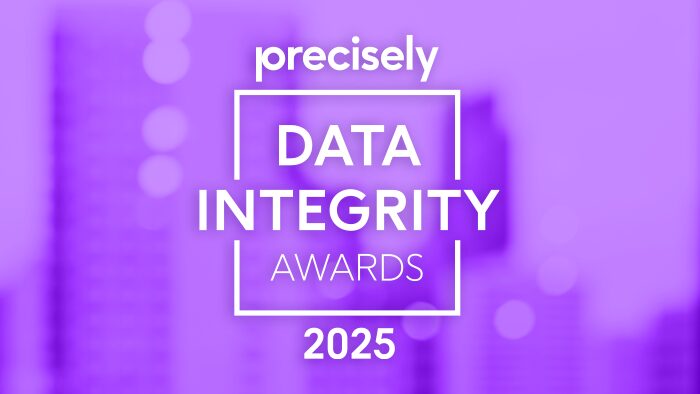The results are in! The 2023 Data Integrity Trends and Insights Report, published in partnership between Precisely and Drexel University’s LeBow College of Business, delivers groundbreaking insights into the importance of trusted data.
For the report, more than 450 data and analytics professionals worldwide were surveyed about the state of their data programs.
One major finding? Data-driven decision-making is the top goal for 77% of data programs. Respondents also report that accelerated data-driven decision-making is the third-ranked outcome of data initiatives.
2023 Data Integrity Trends & Insights
Results from a Survey of Data and Analytics Professionals
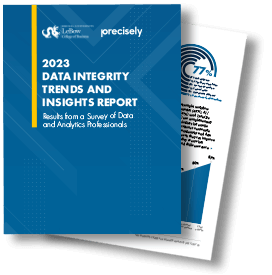
Let’s explore more of the report’s findings around data program investments.
Business goals for data programs
The importance of data to an organization is well understood in today’s business culture, and data leaders are invested in aligning their data programs’ goals with their organizations’ business goals. The 2023 Survey of Data and Analytics Professionals, from the Center for Business Analytics at Drexel University’s LeBow College of Business (LeBow) in partnership with Precisely, asked respondents to share the goals and outcomes of their data programs and initiatives.
More than three-quarters of respondents (77%) say that data-driven decision-making is an important goal of data programs, an increase of 12% over the 2021 survey. Looking at data program goals by business size, 87% of respondents from very large companies (with 5,000+ employees) say data-driven decision-making is important.
Organizations are also putting data programs to work to achieve core operational and financial performance improvements. Operational efficiency ranks a close second in organizational goals for data programs. Smaller companies (250- 500 employees), however, rank operational efficiency importance higher than the average, at 80%.
Overall, cost reduction ranks third in goals at 62%, with very large companies putting more importance on cost at 70%. Revenue generation ranks fourth overall at 59%, followed by regulatory compliance at 57%. In our experience, data-driven decision-making is a critical enabler and force multiplier, improving operational efficiency, cost reduction, revenue generation, and compliance outcomes.
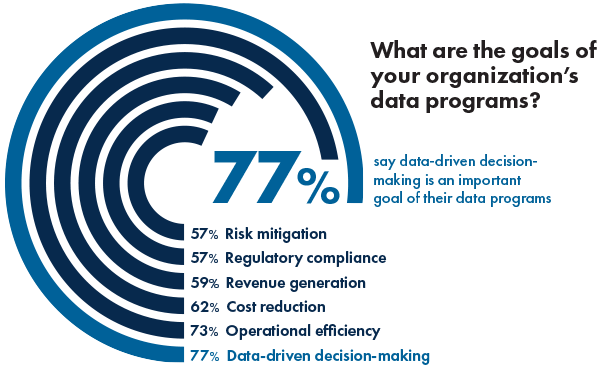
Mapping outcomes to goals of data initiatives and programs
Regarding the outcomes of data initiatives, the greatest number of respondents (50%) say they are seeing efficiency and cost reduction improvements, which they position as their number two and three goals for their data programs. As for whether organizations are meeting the leading goal of data-driven decision-making, 44% of data leaders who have implemented data programs report positive results to that end.
Moreover, 46% of respondents see an increased demand for data, indicating that providing business users with good data can create demand for more of the same. Risk mitigation and regulatory compliance as goals (57% each) and successes (41% and 40% respectively) rank in the middle tier of results, with some success and room for improvement. However, revenue generation cited as a goal (59%) and as an outcome (34%) shows the most significant gap.
The degree of positive results is generally clustered in companies with under 500 employees and companies with 1,000- 5,000 employees. Notably, outcomes for companies with 5,000+ employees fall below the averages of the overall results for efficiency and cost reduction and accelerating data-driven decision-making, but at 58%, significantly lead to increasing demand for data.
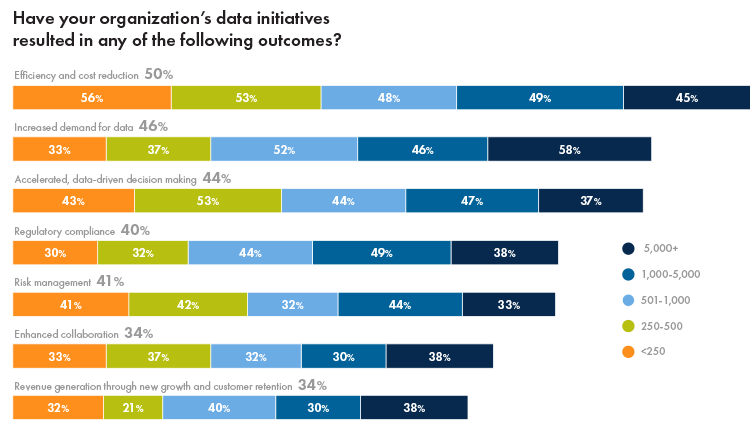
Taking steps to improve the use of data for decision-making
Data leaders recognize that siloed data impedes data-driven decision-making, preventing business leaders from working with a comprehensive and single view of an organization’s truth. We know this because when asked what steps their organizations have taken to improve the use of data for decision-making, more than half (54%) cite using technology and processes to break down data silos and improve data access. The second most frequently selected response, at 47%, is using technology and processes to profile data and improve quality.
Forty percent say they are taking steps involving people, including improving data literacy skills and addressing staffing and resources. Another 40% credit having a data governance program for enhancing decision-making data, while 30% employ data observability tools to proactively identify data issues. And 21% are investing in third-party data to enrich their internal datasets or apply spatial context to add value to data.
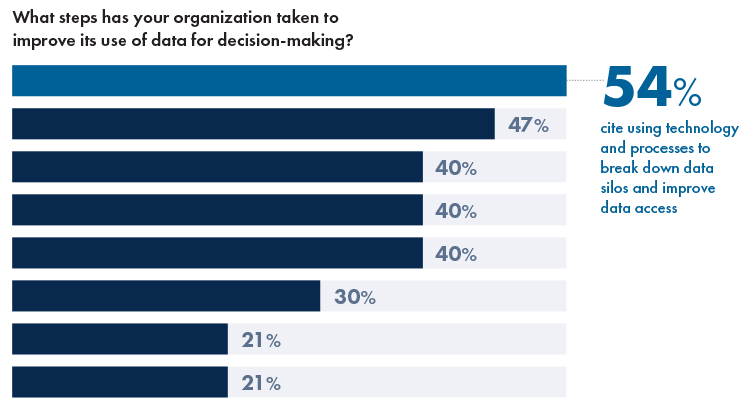
Get inspired for your data integrity journey
How does your data program compare to your peers? Do you have the data integrity needed to achieve and exceed your business goals? For more insights and inspiration for new use cases with trusted data, read the full 2023 Data Integrity Trends and Insights Report.



